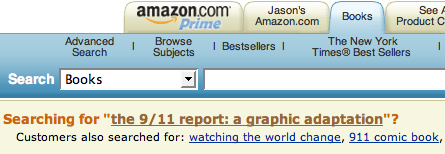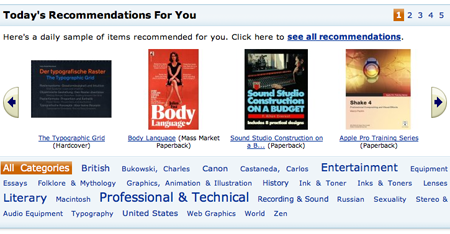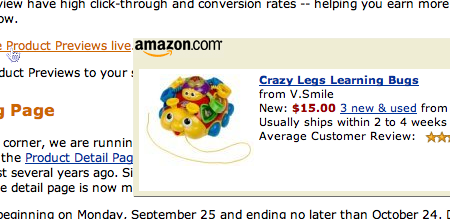A redesign usually implies a major overhaul. But it’s interesting to watch a site like Amazon keep its overall look and feel constant while continually testing new elements. Below are some examples relating to search, recommendations, shipping, etc.





You’re reading Signal v. Noise, a publication about the web by Basecamp since 1999. Happy !
A redesign usually implies a major overhaul. But it’s interesting to watch a site like Amazon keep its overall look and feel constant while continually testing new elements. Below are some examples relating to search, recommendations, shipping, etc.





Josh
on 02 Feb 07Customers are creatures of habit. I think Amazon does a good job of incrementally introducing new features to users and easing people into big changes. This avoids the shock that users of say, Yahoo!, have been feeling. Radical redesigns can backfire when your core customer base is used to and comfortable with the design you’ve had for years (i.e.: the recent Yahoo! TV backlash). I had quite a shock when I logged into Yahoo! Sports last night for the first time in a few days and everything was completely different. It took me awhile to adjust and I still am not sure I care for it. That’s never happened at Amazon.
Ted
on 02 Feb 07Bezos must not be happy that profits drops while revenue increased.
http://www.iht.com/articles/2007/02/02/business/amazon.php
Talking about Bezos, why isn’t his name listed on the sidebar under “Who are 37signals” ?
Dave Davis
on 02 Feb 07I always have mixed feelings about Amazon. As a designer, it hits me like colorful vomit. But as a retail customer, I confess they really “get it” and are way ahead of their time. What always strikes me as clutter usually turns out to be content. They take every opportunity to learn about me, except one: they always fail miserably when it comes to aesthetic appeal. They are the Anti-Apple: All function, no form, beauty ever-sublimated to sell, sell, sell.
In terms of features though, even the odd ball failures, like the “Amazon Customers Vote”, fit with the larger model. It’s about relationships and understanding, both direct and oblique. My participation in ANY of these features will guide and direct Amazon’s efforts to sell me more stuff and/or help them further refine their overall message and vehicle.
Amazon is built on the Prime Principle of dataesthetic design: All information has value. In the past, we had to know or guesstimate that value in advance, to determine whether or not the information was worth preservation. No more. It’s cheaper to store virtually every aspect of our interactions as metadata, in order to use or study it later on, when that value is revealed or more obvious. Amazon’s historic practices are thus “best practices” for a future where value is revealed over time, rather than predicted or assigned.
Rob Rubin
on 02 Feb 07While this isn’t a great analogy, they’re evolving their design much like automobile designers. BMWs look different than 20 or 30 years ago, but they look related.
Nathan
on 02 Feb 07Yeah – I would say the chowhound meltdown after the latest redesign is a good example as well.
Aircraft Guy
on 02 Feb 07Nice job blogging on this. Wow, they sure are creative and come out with a ton of great stuff over there at amazon.com
heri
on 02 Feb 07I used to hate amazon.com because of its aestethics, but i have done a couple of orders there lately and found out about its powerful features. the design never goes againt the user and feel like they are doing their best to give relevant information to me. there is a lesson to be taken here, people
warren
on 02 Feb 07amazon sucks! they’ve cluttered up their pages with useless crap. it’s impossible to find a table of contents (stuff I’m actually looking for). I have to search the text of the page with ctrl+F. and often times they don’t have it.
terry Sutton
on 02 Feb 07Amazon comment not heard: “Huum….that’s different and likely to make this simple task more complicated”
Amazon comment often heard: “Humm….now that’s a neat idea!”
Dave Davis
on 04 Feb 07Amazon definitely takes an evolutionary view, and as in nature, all developments aren’t winners. Some features were ground breaking early on (like lists), but haven’t evolved or kept up well with more free-form list and tagging features. Some are almost superfluous, like their wiki, which potentially duplicates or supercedes their established customer commenting engine. But it’s designed poorly, so it doesn’t really fly.
In the amazon ecosystem, I’d say the wiki will simply go away, rather than evolve… which may or may not be a good thing when you look at their long-term trajectory (the goal seems to be to develop a generic retail platform, like ebay-cum-mall-of-the-universe!). I think they could benefit from a more “designed” structure, where the wiki would “absorb” the reader comments, rather than augmenting or duplicating it on a parallel track.
It seems simple enough to me. But it’s not their way… they’re more of a slash/burn, brute force approach.
Adam Richardson
on 05 Feb 07Coincidentally I recently blogged about this, and it turns out an average Amazon page has something like 220 links. If it’s not overloaded yet, it’s getting there, and seems like incremental additions are not going to work much longer – a more thorough rework will be needed
http://richardsona.squarespace.com/main/2007/1/25/is-amazon-overloaded.html
Gavin
on 05 Feb 07I agree with many of these comments…Amazon is way too cluttered with crap I’ll never click on.
This discussion is closed.